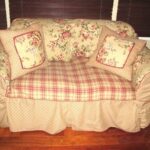Indoor or outdoor, furniture is expensive. Making your own is a viable and money- saving alternative. Build your own PVC sectional sofa and save money. You can customize the measurements, so the sofa fits in any room or space you choose.
This sofa is versatile. The sections can be used separately or together. It can double as a daybed. Build a frame or two without arms and create a matching ottoman. Top with plywood, hard plastic sheet or fabric. It is inspired by the sectional sofas in stores today. Their designs all look straightforward.
This design is made using sections measuring 16″ by 16″ for the seats and 16″ for the arm and back section. The sections will measure between 32″ to 34″ from the floor. Of course, the pieces can be adjusted to match any size.
You can customize this design any way you wish to create a truly custom sofa. If funds are tight, build each section as you can afford it.
If you have never worked with PVC before, reading the article at this link will give valuable tips on how to handle it. Building PVC furniture takes a little practice, and this link will help.
PVC comes in different colors such as white, clear, red, blue yellow and green. Most PVC from the DIY store is white. You can indeed paint or stain your PVC sectional sofa to match your décor.
Wrapping the seat with twine or rope is a wonderful way to create an inexpensive and beautiful seat. Practically any type of strong paracord, twine, raffia or rope can be used. Follow this link to learn how.
You can give the PVC sectional sofa a solid seat with plywood or weave a seat in place. Research different materials to ensure the seat’s strength when used.
Do not glue anything together until instructed to do so.
You will need:
- · PVC pipe- 1″ schedule 40
- · Three- way fittings, 1″
- · Four- way fittings, 1″
- · Corner fittings, 90º angles, 1″
- · Hacksaw
- · Clear PVC primer and cement
- · Sandpaper to smooth edges
- · Paint or dye
Step One:
Build a corner piece.
Cut 16 pieces of PVC pipe, each 15 ½” long. Lay four pieces in a square on the floor. Attach in a square using three-way fittings, with one pipe sticking up. Place a piece in each fitting. Place a three-way fitting on one piece, and four-way fittings on the other three.
Attach a top square by inserting pieces in each of the fittings. The four-way fittings will have a fitting hole pointing up.
Place three pieces in each of the fittings. Place a three-way fitting on the middle piece, and 90º fittings on the other two. The holes should point to the middle piece, and the three-way corner holes should point to the outside pieces. Fit two pieces between the connectors.
Measure the corners to ensure everything is square and sits flat on the ground. If not, adjust the pieces now.
Step Two:
Build a sidepiece.
Begin as before, but use two three-way connectors on two corners. You will have two poles coming up for the back. Place 90º connectors on the two pieces, and one piece between them.
Step Three:
Build an ottoman.
Begin as in step one, making the box. Use three-way connectors for all four top pieces.
Step Four:
Cover the seats with plywood, fabric, caning or twine. Make or purchase cushions for the seats and backs.
Place the sections together to create a sofa for the chosen space. If everything looks good, the heights match and the sections are stable, disassemble each piece and cement it together. Wait at least 24 hours before proceeding further.
If painting or staining the PVC is desired, do it before applying the seats and backs.
Notes:
- · For a nautical and modern theme, measure the inside spaces for the backs and arms. Make inserts using heavy fabrics like canvas with grommets placed evenly. Use paracord or other cording to attach to the backs, arms and seats. If using for seats, ensure the fabric is tight and does not sag.
- · Use end caps for the feet or place the frames on casters to create movable furniture. When you build your own PVC sectional sofa, the only limits are your imagination.
- · Make a double section by changing the connectors at the sides. This works well for children’s furniture, but reduces the strength by eliminating one of the supports. Using T-connectors and adding pieces on either side of the center piece will add strength. Add pieces at the corners for strength and to create a design pattern.
- · For a decorative touch on a patio or deck, cut plastic lattice and attach to the bottoms, sides and backs of the sections.
- · The sections will stay together. For added stability, tie the sections together at the legs or drill a hole at the top and bottom of each adjoining section piece. Thread a bolt or string through.
- · For mobility, add casters to the bottom.
- ·. For far less than the cost of custom or ready-made furniture, you will have furniture that fits you and your space exactly.
By using outdoor fabrics with UV stabilizers and UV sealants, your furniture will last for years to come. It will not rot, mold or grow fungus. Insects do not bother PVC.
Source: The author of this article has over 40 years of experience in diverse forms of DIY, home improvement and repair, crafting, designing, and building furniture, outdoor projects and more.




